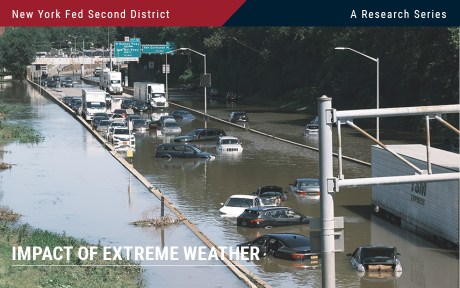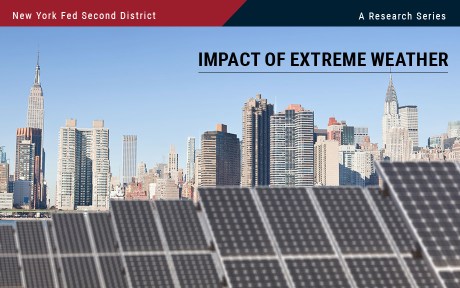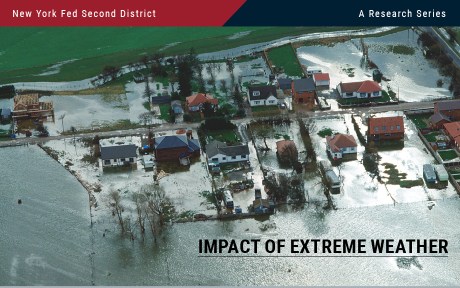
The frequency and ferocity of extreme weather events, such as flooding, storms, and deadly heat waves, have been on the rise in recent years. These climate events, along with human adaption to cope with them, may have large effects on the economy and financial markets. It is therefore paramount to provide research about the economy’s vulnerability to climate events for policymakers, households, financial institutions, and other players in the world economy to make informed decisions. In the coming days, we are going to present a series of nine posts that attempt to take a step in this direction while focusing on the Federal Reserve System’s Second District (NY, northern NJ, southwest CT, Puerto Rico, and the U.S. Virgin Islands). The twelve Federal Reserve Districts are depicted in this map.
Physical and Transition Risks
The first two posts provide a topographical view of the Second District’s exposure to two types of climate risk: physical and transition. Physical risks are created by extreme weather events such as storms, floods, and wildfires. Transition risks arise as the economy moves from its reliance on carbon-based energy toward using zero carbon on a net basis. These risks may arise due to numerous factors such as changes in households’ preferences, firm innovations, or government policy.
1. Comparing Physical Risk: The Fed’s Second District vs. the Nation (November 8)
2. Transition Risks in the Fed’s Second District and the Nation (November 9)
Flood Risks: New Data and Implications
The next set of posts in the series zooms in on one of the most relevant physical risks for the Second District: floods. In the initial post, the authors discuss the prevalence of inaccuracies in flood maps in the District. Flood maps are important because they identify 100-year flood risk areas—the Special Flood Hazard Areas (SFHAs)—which are regions that have a chance of flooding “at least” once in 100 years and where flood insurance is mandatory. In the following post, the authors examine how banks lend in “inaccurately mapped” areas. In the final post of this part of the series, the authors discuss whether firms in the Second District consider flood risk when deciding where they conduct business, produce goods, or render services.
3. Potential Flood Map Inaccuracies in the Fed’s Second District (November 10)
4. How Do Banks Lend in Inaccurate Flood Zones in the Fed’s Second District? (November 13)
5. Flood Risk and Firm Location Decisions in the Fed’s Second District (November 14)
Impact of Extreme Weather Events on Small Business Owners
The next two posts in the series continue the examination of how firms respond to climate risks by using several data sets to study how small business owners are affected by different extreme weather events in the Second District.
6. How Do Natural Disasters Affect Small Business Owners in the Fed’s Second District? (November 15)
7. Small Business Recovery after Natural Disasters in the Fed’s Second District (November 16)
The Impact of Hurricanes
The last two posts provide case studies of the impact of hurricanes in the Second District. The first post examines how basement apartment renters are exposed to flood risk in New York City. The final post of the series provides a case study on the impact of hurricanes on banks headquartered in Puerto Rico.
8. Flood-Prone Basement Housing in New York City and the Impact to Low- and-Moderate Income Renters (November 17)
9. Banks versus Hurricanes (November 20)
Concluding Remarks
As the blog posts of this series will show, extreme weather events can have far reaching effects on households, business owners and financial intermediaries in the Second District. The research on these phenomena is in its infancy, and so further data collection and analytical work are needed to inform policymakers and the public on the potential economic and financial ramifications of future climate events.

Julian di Giovanni is the head of Climate Risk Studies in the Federal Reserve Bank of New York’s Research and Statistics Group.
How to cite this post:
Julian di Giovanni, “Blog Series on the Economic and Financial Impacts of Extreme Weather Events in the Fed’s Second District,” Federal Reserve Bank of New York Liberty Street Economics, November 8, 2023, https://libertystreeteconomics.newyorkfed.org/2023/11/blog-series-on-the-economic-and-financial-impacts-of-extreme-weather-events-in-the-feds-second-district/.
Disclaimer
The views expressed in this post are those of the author(s) and do not necessarily reflect the position of the Federal Reserve Bank of New York or the Federal Reserve System. Any errors or omissions are the responsibility of the author(s).













 RSS Feed
RSS Feed Follow Liberty Street Economics
Follow Liberty Street Economics